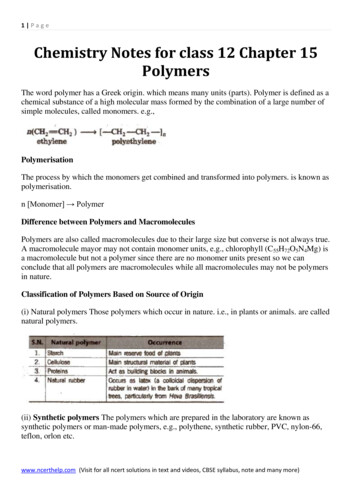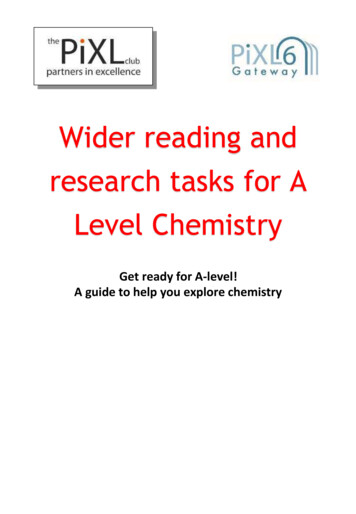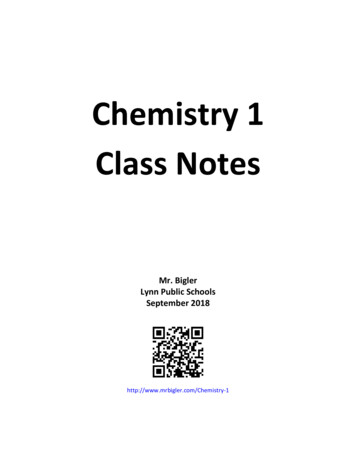
Transcription
1 PageChemistry Notes for class 12 Chapter 15PolymersThe word polymer has a Greek origin. which means many units (parts). Polymer is defined as achemical substance of a high molecular mass formed by the combination of a large number ofsimple molecules, called monomers. e.g.,PolymerisationThe process by which the monomers get combined and transformed into polymers. is known aspolymerisation.n [Monomer] PolymerDifference between Polymers and MacromoleculesPolymers are also called macromolecules due to their large size but converse is not always true.A macromolecule mayor may not contain monomer units, e.g., chlorophyll (C55H72O5N4Mg) isa macromolecule but not a polymer since there are no monomer units present so we canconclude that all polymers are macromolecules while all macromolecules may not be polymersin nature.Classification of Polymers Based on Source of Origin(i) Natural polymers Those polymers which occur in nature. i.e., in plants or animals. are callednatural polymers.(ii) Synthetic polymers The polymers which are prepared in the laboratory are known assynthetic polymers or man-made polymers, e.g., polythene, synthetic rubber, PVC, nylon-66,teflon, orlon etc.www.ncerthelp.com (Visit for all ncert solutions in text and videos, CBSE syllabus, note and many more)
2 Page(iii) Semisynthetic polymers Polymers obtained by making some modification in naturalpolymers by artificial means, are known as semi synthetic polymers, e.g., cellulose acetate(rayon), vulcanised rubber etc.Classification of Polymers Based on Structure(i) Linear polymers These are the polymers in which the monomer units are linked to oneanother to form long linear chains. These linear chains are closely packed in space. The closepacking results in high densities, tensile strength and high melting and boiling points. e.g., highdensity polyethene, nylon and polyesters are linear polymers.(ii) Branched chain polymers In such polymers, the monomer units are linked to form longchains with some branched chains of different lengths with source. As a result of branching,these polymers are not closely packed in space. Thus, they have low densities, low tensilestrength as well as low melting and boiling points. Some common examples of such polymersare low density polyethene, starch, glycogen etc.(iii) Cross-linked polymers or network polymers In such polymers, the monomer units arelinked together to form three dimensional network. These are expected to be quite hard, rigidand brittle. Examples of cross linked polymers are bakelite, glyptal, melamine-formaldehydepolymer etc.Classification of Polymers Based on Mode of Polymerisation(i) Addition polymers The polymers formed by the polymerisation of monomers containingdouble or triple bonds (unsaturated compounds) are called addition polymers. Additionpolymers have the same empirical formula as their monomers.Addition polymers can further be classified on the basis of the typesof monomers into the following two classes:www.ncerthelp.com (Visit for all ncert solutions in text and videos, CBSE syllabus, note and many more)
3 PageHomopolymers The polymers which are obtained by the polymerisation of a single type ofmonomer are called homopolymers.Copolymers The polymers which are obtained by the polymerisation of two or moremonomers are called copolymers(ii) Condensation polymers The polymers which are formed by the combination of monomerswith the elimination of small molecules such as water, alcohol, hydrogen chloride etc., areknown as condensation polymers, e.g., nylon 6,6 is formed by the condensation ofhexamethylene diamine with adipic acid.Classification of Polymers Based on Molecular Forces1. Elastomers These are rubber like solid polymers in which the polymer chains are heldtogether by weakest intermolecular forces, e.g., natural rubber, buna-S, buna-N etc . Theweak binding forces permit the polymers to be stretched. A few ‘cross links’ areintroduced in between the chains, which help the polymer to retract to its originalposition after the force is released as in vulcanised rubber.2. Fibres Fibres belong to a class of polymers which are thread-like and can be woven intofabrics. These are widely used for making clothes, nets, ropes, gauzes, etc. Fibrespossess high tensile strength because the chains possess strong intermolecular forcessuch as hydrogen bonding. The fibres are crystalline in nature and have sharp meltingpoints. A few examples of this class are nylon-66, terylene and polyacrylonitrile.www.ncerthelp.com (Visit for all ncert solutions in text and videos, CBSE syllabus, note and many more)
4 Page3. Thermoplastics These are linear polymers and have weak van der Waals’ forces actingin the various chains. These forces are intermediate of the forces present in theelastomers and in the fibres. When heated, they melt and form a fluid which sets into ahard mass on cooling. Thus, they can be cast into different shapes by using suitablemoulds, e.g., polyethene and polystyrene.(Plasticizers are high boiling esters or haloalkanes. These are added to I plastics to makethem soft rubber like. J4. Thermosetting plastics These are normally semifluid substances with low molecularmasses. When heated, they become hard and infusible due to the cross-linking betweenthe polymer chains. As a result, they also become three dimensional in nature. A fewcommon thermosetting polymers are bakelite, melamine-formaldehyde resin and ureaformaldehyde resin.Types of Polymerisation1. Chain Growth Polymerisation or Addition PolymerisationIt involves formation of reactive intermediate such as free radical, a carbocation or a carbanion.For this polymerisation monomers used are unsaturated compounds like alkenes; alkadienesand their derivatives. Depending upon the nature of the reactive species involved. chain growthpolymerisation occurs by the following mechanisms: Free radical addition polymerisationCationic polymerisationAnionic polymerisation(i) Free radical addition polymerisation The monomers used are generally monosubstitutedalkenes. The most commonly used catalysts are benzoyl peroxide, hydrogen peroxide or t-butylperoxide etc.Mechanism The reaction involves the following stepsStep I Chain initiation step In this step, peroxide undergoes homolytic fission, e.g., benzoylperoxide on heating produces phenyl initiator free radical.www.ncerthelp.com (Visit for all ncert solutions in text and videos, CBSE syllabus, note and many more)
5 PageStep II Chain propagation step The new free radical adds to another molecules of monomerto form a larger free radical.Step III Chain termination step There are three ways of chain termination: Couplingreaction, disproportionation reaction, chain transfer reaction. One mode of termination of chainis shown as under:(ii) Cationic polymerisation It involves formation of carbocation which are generated byLewis acids (like BF3, AICI3, SnCI4, etc.) and protonic acids such as H2SO4, HF, etc.Higher the stability of carbocation intermediate, more is the reactivity of monomers towardscationic addition polymerisation. It involves the following steps:Step I. Initiation Stepwww.ncerthelp.com (Visit for all ncert solutions in text and videos, CBSE syllabus, note and many more)
6 Page(iii) Anionic polymerisation It involves formation of a carbanion, Steps involved in thisprocess areStep I Initiation Strong bases act as initiator.Step Growth PolymerisationCondensation polymerisation which occurs in a stepwise manner with elimination of somesmaller molecules like H2O, NH3, HCI, ROH, etc., is concerned with step growthpolymerisation, e.g., adipic acid and hexamethylenediamine phenol and formaldehyde etc.,undergo step Growth Polymerisation.Distinction Between Chain Growth Polymerisation and Step Growth PolymerisationMolecular Mass of PolymersThe growth of the polymer chain depends upon the availability of the monomers in thereaction. Thus, the polymer sample contains chain of varying lengths and hence, its molecularmass is always expressed as an average molecular mass.www.ncerthelp.com (Visit for all ncert solutions in text and videos, CBSE syllabus, note and many more)
7 PageNumber-Average Molecular Mass MnIf N1 molecules have molecular mass M1 each, N2 molecules have molecular mass M2 each,N3molecules have molecular mass M3 each and so on,then, Mn Σ Ni Mi / Σ NiIt is determined by osmotic pressure method.It is determined by light scattering and ultracentrifugation method.PoLydispersity IndexIt is the ratio of the mass average molecular mass to the number average molecular massPDI Mw / MnFor natural polymers, PDI is usually equal to one which means that they are monodisperse. Inother words, such polymers are more homogeneous. On the contrary, synthetic polymersgenerally have PDI 1 which means that they are less homogeneous.PolyolefinsThese are obtained by the addition polymerisation of ethylene and its derivatives1. PolythenePolymer of ethylene or ethene.(i) Low density polythene (LDP)www.ncerthelp.com (Visit for all ncert solutions in text and videos, CBSE syllabus, note and many more)
8 PageIt is tough, flexible, transparent, chemically inert as well as poor conductor pf electricity. It hasmoderate tensile strength but good tearing strength.It is used in the insulation of electricity carrying wires and manufacture of queeze bottles, toyesand flexible pipes.(ii) High density polyethylene (HOP)It has high density due to close packing. It is also chemically inert and more tougher andharder.It is used for making containers, house wares, bottles, toyes, electric insulation etc.2. Polystyrene (Styrone)The monomers are styrene molecules. It is thermoplastic. It is used for making toys, radio andTV cabinets3. Polyvinylchloride (PVC)It is used for making rain coats, toys, electrical insulation. It is hard and resistant to heat andchemicals.4. Polypropylene (PP)It is obtained by polymerising propylene in the presence of Ziegler-Natta catalyst.www.ncerthelp.com (Visit for all ncert solutions in text and videos, CBSE syllabus, note and many more)
9 PageIt is chemically inert and resistant to attack by corrosive reagent. It is used in making oil seals,gaskets and also for non-stick surface coated utensils.6. PolyacrylonitrileIt is used as a substitute for wool in making commercial fibres as orIon or acrilan.PolyamidesThe polymers which contain an amide linkage in chain are known as pOlyamide, e.g., nylon-6,6.1. Nylon-66It is obtained by the condensation of adipic acid and hexamethylenediamine with theelimination of water moleculewww.ncerthelp.com (Visit for all ncert solutions in text and videos, CBSE syllabus, note and many more)
10 P a g eThe polyamides are identified by numbers. These numbers refer to the number of carbon atomsin diamine and in the dibasic acid. As in the above case, the carbon atoms are 6 in each case,therefore the product is described as nylon-66.Properties and usesNylon-66 is a linear polymer and has very high tensile strength. It shows good resistance toabrasion. Nylon-66 is usually fabricated into sheets. It is used in bristles for brushes and intextile2. Nylon-6Nylon-6 is obtained by heating caprolactam with water at a high temperature.Resins1. Phenol-Formaldehyde Polymer(Bakelite and Related Polymers)www.ncerthelp.com (Visit for all ncert solutions in text and videos, CBSE syllabus, note and many more)
11 P a g eThese polymers are obtained by the condensation reaction of phenol with formaldehyde in thepresence of either acid or a base catalyst. The reaction involves the formation of methylenebridge at ortho, para or both ortho and para positions. A linear or cross linked material isobtained depending upon the condition of reaction.Useswww.ncerthelp.com (Visit for all ncert solutions in text and videos, CBSE syllabus, note and many more)
12 P a g eBakelite is used for making combs, photograph records, electrical switches etc. Soft bakeliteswith low degree of polymerisation are used as binding glue for laminated wooden plants, invarnishes and lacquers.2. Melamine-formaldehyde ResinIt is a copolymer formed by the polymerisation of melamine (which is a heterocyclic triamine)and formaldehyde as follows :Properties and UsesIt is very hard and tough. It has assumed great importance these days particularly in makingcrockery. They do not break even when droped from a height.3. Urea-formaldehyde Resinwww.ncerthelp.com (Visit for all ncert solutions in text and videos, CBSE syllabus, note and many more)
13 P a g e4. Natural RubberNatural.rubber is a coiled linear 1, 4-polymer of isoprene.In the polymer chain of natural rubber, the residual double bonds are located between C2 andC3 of the isoprene unit. All these double bonds have cis configuration, and thus natural rubberis cis-l,4-polyisoprene.In the natural rubber, there is no polar substituent. The only intermolecular forces are van derWaals’ type. The cis-configuration gives the polymeric chain of natural rubber a coiledstructure. As a result, it can be stretched by the application of a force. When the force isremoved, the chain returns back to its original coiled shape.Natural rubber is soft and sticky. It can be used only in the temperature range 10 C-50 C. Athigher temperature, it becomes soft and at low temperature, it becomes brittle. It has higb waterabsorption capacity. It is attacked by oxidising agents and organic solvents. As such, it cannotbe used very extensively for commercial puposes.Vulcanisation of RubberThe properties of natural rubber can be modified by introducing -S-S- polysulphide crosslinksin its structure. This process of introducing -S-S- crosslnks in the structure of natural rubber byheating with sulphur at 11O C is called vulcanlsation of rubber.Vulcanisatlon is carried out by adding sulphur (3-5%) and zinc oxide to the rubber, and thenheating the object at about 110 Cfor about 20-30 minutes. Zinc oxide accelerates the rate ofvulcanisation. Vulcanisation introduces polysulphide (-S-S-) bonds between the adjacentchains. These crosslinks tend to limit the motion of chains relative to each other.5. NeoprenePolymer formed by polymerisation of chloroprene is neoprene or synthetic rubber.www.ncerthelp.com (Visit for all ncert solutions in text and videos, CBSE syllabus, note and many more)
14 P a g eIt is used for the manufacturing conveyers belts, gasket and hoses.6. Buna-NIt is a copolymer of buta-I, 3-diene and acrylonitrile. It is formed as followsProperties and UsesIt is insulator in nature and is used for making conveyor belts and printing rollers.PolyestersThe polymers which contain an ester linkage are known as polyester, e.g., dacron.1. Polymethylmethacrylate (PMMA)It is prepared by the polymerisation of methylmethacrylate in the presence of suitable organicperoxide.The polymer is known by several commercial names such as lucite, acrylite, plexiglass andperspex.Properties and useswww.ncerthelp.com (Visit for all ncert solutions in text and videos, CBSE syllabus, note and many more)
15 P a g eIt is a hard and transparent polymer and is quite resistant to the effect of light, heat and ageing.It is used, in the manufacture of unbreakable lights, protective coatings, dentures, and inmaking windows for aircrafts.2. GlyptalIt is a polyester having crosslinks. It is a thermosetting plastic. It is obtained by condensation ofethylene glycol and phthalic acid or glycerol and phthalic acid.When its solution in a suitable solvent is evaporated, it leaves a tough but non-flexible film. Itis, therefore, used in the manufacture of paints and lacquers.3. Terylene (Dacron)It is a condensation product of ethylene glycol and terephthalic acid.Polymerisation is carried out at 420 to 460 K in the presence of catalyst mixture of zinc acetateand antimony trioxide.www.ncerthelp.com (Visit for all ncert solutions in text and videos, CBSE syllabus, note and many more)
16 P a g eProperties and usesTerylene is highly resistant to the action of chemical and biological agents. Its fibres are quitestrong and durable. It can also be blended with wool or cotton to obtain fabrics of desiredcomposition.Terylene is used in the manufacture of a variety of clothes such as terycot, terywool andterysilk as a result of blending with other yerns. It is also used for preparing magnetic recordingtapes, conveyer belts, aprons for industrial workers etc.Biopolymers and Biodegradable PolymersSynthetic polymers are mostly non-biodegradable i.e., it is very difficult to dispose off thepolymeric waste, e.g., polythene bags.Nature has provided us a variety of polymers which can be produced by the biological systemsin plants and animals. These are called biopolymers, e.g., polysaccharides, proteins, nucleicacids, etc. In the biological system, these polymers decompose or hydrolyse in the Presence ofdifferent enzymes. This means that they are biodegradable.Aliphatic polyesters are the common examples of biodegradable Polymers.It is a copolymer of 3-hydroxybutanoic acid and 3-hydroxypentanoic acid.2. Nylon-2-Nylon-6It is an alternating polyamide copolymer of glycine (H2N-CH2-COOH) and amino caproic acid[H2N(CH2) 5COOH] and is biodegradable.Some More Impotant Polymers1. Saran is a copolymer of vinyl chloride and Isused for wrapping food materials.2. ASS rubber is a copolymer of acrylonitrile, buta-1, 3-diene and styrene.3. Bubble gum contains styrene butadiene rubber.www.ncerthelp.com (Visit for all ncert solutions in text and videos, CBSE syllabus, note and many more)
17 P a g e4. Epoxy resins are used In making adhesives such as araldite, etc. These are the copolymerof epichlorohydrin and bisphenol-A.5. Thikol is another variety of synthetic rubber which is a copolymer of ethylene chlorideand sodium tetrasulphide (Na2S4).6. Dynells a copolymer of vinyl chloride and acrylonitrile and is used for making humanhair wigs.7. Silk Is a thread like natural polymer which is obtained from cocoons of sllk worms. It isa natural polyamide fibre.8. Thermocol Is a foamed plastic obtained by blowing air through molter polystyrene orpolyurethane.9. Superglue is a polymer of methyl α-cyanoacrylate and is obtained by anionicpolymerisation of monomer.www.ncerthelp.com (Visit for all ncert solutions in text and videos, CBSE syllabus, note and many more)
Chemistry Notes for class 12 Chapter 15 Polymers The word polymer has a Greek origin. which means many units (parts). Polymer is defined as a chemical substance of a high molecular mass formed by the combination of a l











